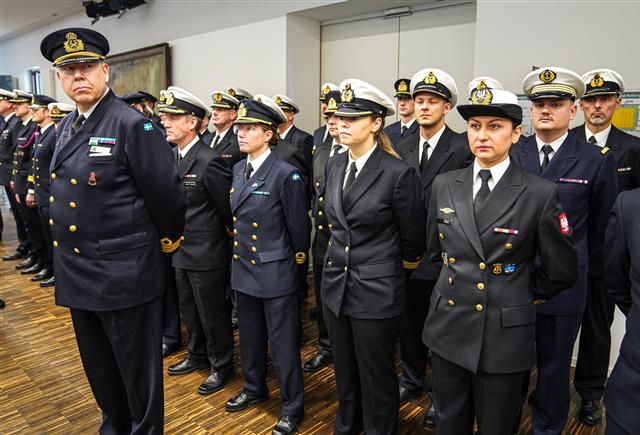At the ceremony, Allied Maritime Command was represented by its Deputy Commander, Vice Admiral Didier Maleterre. He appreciated “the ironclad commitment of Germany and our Baltic Allies” for addressing current security challenges. “Our thanks go in particular to the German Navy, who has worked tirelessly to set up this headquarters, but also to all the Baltic Allies – Denmark, Estonia, Finland, Latvia, Lithuania, Poland, Sweden – who have collaborated in its stand-up and will take on important roles in the staff”, said Maleterre.
Like other CTFs, CTF Baltic has two core missions: to plan maritime exercises and operations and to lead naval forces assigned by NATO in times peace, crisis and war. Additionally, it will play a key role in fostering cooperation between the allied navies in the Baltic Sea region. The new headquarters will be a critical command structure for the execution of NATO’s Regional Plan, if necessary.
Vice Admiral Maleterre explained that thanks to all the partner nations’ navies supporting CFT Baltic, its coordination and tactical command fusion would provide NATO with a strengthened deterrent posture in the Baltic Sea region. “As a result, this CTF will be critical to develop tactical plans in the region, to gain significant operational advantage, and to retain decision superiority.”
Formally, CTF Baltic is a German national headquarters with multinational participation, initially led by a German admiral. The position of his deputy is initially filled by a Polish flag officer, the position of chief of staff by a Swedish staff officer. A rotation is planned after four years at the latest. The core of the personnel is provided by the national operations staff DEU MARFOR, established at the Germany Navy Headquarters since 2019.
The sheer number of nations involved, extending beyond the Baltic Sea states, is clear proof that security in the region affects the whole Alliance
Vice Admiral Jan Christian Kaack, Germany’s Chief of Navy, thanked the nations that already provide personnel for CTF Baltic. “The sheer number of nations involved, extending beyond the Baltic Sea states, is clear proof that security in the region affects the whole Alliance,” said Kaack, adding: “I would also like to thank those nations who did express an interest in joining but have yet to decide on their commitment. We are eagerly anticipating any contribution you would like to make to this.”
The headquarters may number up to 180 personnel in its so-called Peacetime Establishment, growing up to a planned maximum of 240 in its Crisis Establishment. Besides Germany, twelve other nations are contributing personnel at the moment: Denmark, Estonia, Finland, France, Italy, Latvia, Lithuania, the Netherlands, Norway, Poland, Sweden and the United Kingdom. Personnel from these and other partner countries already fill up to 60 multinational positions with CTF Baltic.
“In the end, it is not ships that fight. It is people,” expressed Minister Pistorius his appreciation. “That is why I want to recognize the work of and, more importantly, thank those men and women who have contributed to bringing the idea of this Commanders Task Force to life. And I want to thank those who serve here and in NATO. You embody the very spirit of our Alliance. Your professionalism and commitment are the foundation of our security,” said the Minister of Defence.
Finally, the German Chief of Navy looked ahead. Kaack referred particularly to a full calendar for the upcoming year, which includes the prominent naval exercises BALTOPS 2025 and Northern Coasts 2025. “Assuming this leadership responsibility in the Baltic Sea now means that the German Navy has to meet particularly high standards for the quality of our work,” said the admiral, “and this must be done 365 days a year and around the clock.”
Story by Marcus Mohr, Commander Task Force Baltic Public Affairs / Public Affairs Office at MARCOM
